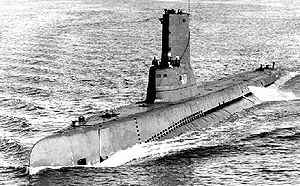- Tench class submarine
-

Class overview Builders: Portsmouth Naval Shipyard, Electric Boat Company, Boston Navy Yard[1] Operators:  United States Navy
United States NavyPreceded by: Balao class Succeeded by: Barracuda class Subclasses: Corsair class Built: 1944–1951[2] In commission: 1944–1975[2] Completed: 29[1] Cancelled: 51[1] Active: 1[1] Lost: 0[1] Retired: 28[1] Preserved: 2[1] General characteristics Type: Diesel-electric submarine Displacement: 1,570 tons (1,595 t) surfaced[1]
2,416–2,429 tons (2,455–2468 t) submerged[1]Length: 311 ft 8 in – 311 ft 9 in (95.0 m)[1] Beam: 27 ft 3 in – 27 ft 4 in (8.3 m)[1] Draft: 17 ft (5.2 m) maximum[1] Propulsion: 4 × diesel engines driving electrical generators (Fairbanks-Morse or General Motors)[1]
2,740 shp (2.0 MW) submerged[1]
2 × 126-cell Sargo batteries[3]
2 × low-speed electric motors (Elliott Company, General Electric, or Westinghouse)[1]
two propellers[1]
5,400 shp (4.0 MW) surfaced[1]Speed: 20.25 knots (38 km/h) surfaced[3]
8.75 knots (16 km/h) submerged[3]Range: 11,000 nautical miles (20,000 km) surfaced at 10 knots (19 km/h)[3] Endurance: 48 hours at 2 knots (3.7 km/h) submerged[3]
75 days on patrolTest depth: 400 ft (120 m)[3] Complement: 10 officers, 71 enlisted[3] Armament: 10 × 21-inch (533 mm) torpedo tubes
(six forward, four aft)
28 torpedoes [3]
1 × 5-inch (127 mm) / 25 caliber deck gun [3]
Bofors 40 mm and Oerlikon 20 mm cannonTench-class submarines were a type of submarine built for the United States Navy (USN) between 1944 and 1951. They were an evolutionary improvement over the Gato and Balao classes, only about 35 to 40 tons larger, but more strongly built and with a slightly improved internal layout. Further improvements were made beginning with SS-435, which are sometimes referred to as Corsair class.
Initial plans called for 146 to be built, but 115 were cancelled in 1944 and 1945 when it became apparent that they would not be needed to defeat Japan. The remaining 31 were commissioned between October 1944 (Tench) and February 1951 (Grenadier).
One Tench (ex-Cutlass was transferred from the USN to the Republic of China Navy as Hai Shih. Two went to Italy as the Gianfranco Gazzana-Priaroggia class. USS Argonaut (SS-475) was sold to the Royal Canadian Navy in 1968, renamed Greater Underwater Propulsion Power Program). The difference is noticeable by the level foredeck and the rounded bow.[4]
Museums
Three Tench Class submarines are on display for the general public.
- USS Requin (SS-481) at the Carnegie Science Center in Pittsburgh, PA.
- USS Torsk (SS-423), moored at Pier Three, Baltimore's Inner Harbor, (alongside the National Aquarium in Baltimore) in Maryland.
- USS Thornback (SS-418), on display at Rahmi M. Koç Museum, Golden Horn in Istanbul.
See also
 Media related to Tench class submarines at Wikimedia Commons
Media related to Tench class submarines at Wikimedia CommonsReferences
- ^ a b c d e f g h i j k l m n o p q Bauer, K. Jack; Roberts, Stephen S. (1991). Register of Ships of the U.S. Navy, 1775-1990: Major Combatants. Westport, Connecticut: Greenwood Press. pp. 280–282. ISBN 0-313-26202-0.
- ^ a b Friedman, Norman (1995). U.S. Submarines Through 1945: An Illustrated Design History. Annapolis, Maryland: United States Naval Institute. pp. 285–304. ISBN 1-55750-263-3.
- ^ a b c d e f g h i U.S. Submarines Through 1945 pp. 305-311
- ^ http://www.globalsecurity.org/military/systems/ship/guppy.htm
United States naval ship classes of World War IIAircraft carriers Light aircraft carriers Escort carriers Battleships Large cruisers Heavy cruisers Light cruisers Destroyers Destroyer escorts Patrol frigates Minesweepers Submarines - S — Single ship of class
- C — Completed after the war
- X — Cancelled
Categories:- Submarine classes
- Tench class submarines
- World War II submarines of the United States
- Cold War submarines of the United States
- Korean War submarines of the United States
- Vietnam War submarines of the United States
Wikimedia Foundation. 2010.
